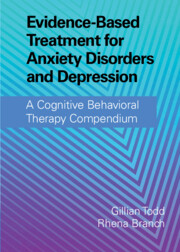 Evidence-Based Treatment for Anxiety Disorders and Depression
Evidence-Based Treatment for Anxiety Disorders and Depression Book contents
- Evidence-Based Treatment for Anxiety Disorders and Depression
- Evidence-Based Treatment for Anxiety Disorders and Depression
- Copyright page
- Contents
- Figures
- Tables
- Contributors
- 1 Introduction
- 2 The History and Philosophical Underpinnings of CBT:
- Part One Cognitive Behavioral Therapy for Anxiety Disorders
- 3 CBT for Specific Phobias
- 4 CBT for Panic Disorder
- 5 The Cognitive Behavioral Treatment of Agoraphobia
- 6 Cognitive Behavioral Therapy for Social Anxiety Disorder
- 7 CBT for Social Anxiety Disorder
- 8 CBT for Somatic Symptom Disorder and Illness Anxiety Disorder
- 9 Cognitive Behavioral Therapy for Generalized Anxiety Disorder:
- Part Two Cognitive Behavioral Therapy for Posttraumatic Stress Disorder
- Part Three Cognitive Behavioral Therapy for Obsessive-Compulsive Disorder and Associated Disorders
- Part Four Cognitive Behavioral Therapy for Depression
- Part Five Complexity and Comorbidity in Anxiety Disorders and Depression:
- Part Six Specialist Applications of Cognitive Behavioral Therapy for Anxiety Disorders and Depression
- Part Seven Future Developments
- Appendices
- Index
- References
4 - CBT for Panic Disorder
from Part One - Cognitive Behavioral Therapy for Anxiety Disorders
Published online by Cambridge University Press: 06 January 2022
- Evidence-Based Treatment for Anxiety Disorders and Depression
- Evidence-Based Treatment for Anxiety Disorders and Depression
- Copyright page
- Contents
- Figures
- Tables
- Contributors
- 1 Introduction
- 2 The History and Philosophical Underpinnings of CBT:
- Part One Cognitive Behavioral Therapy for Anxiety Disorders
- 3 CBT for Specific Phobias
- 4 CBT for Panic Disorder
- 5 The Cognitive Behavioral Treatment of Agoraphobia
- 6 Cognitive Behavioral Therapy for Social Anxiety Disorder
- 7 CBT for Social Anxiety Disorder
- 8 CBT for Somatic Symptom Disorder and Illness Anxiety Disorder
- 9 Cognitive Behavioral Therapy for Generalized Anxiety Disorder:
- Part Two Cognitive Behavioral Therapy for Posttraumatic Stress Disorder
- Part Three Cognitive Behavioral Therapy for Obsessive-Compulsive Disorder and Associated Disorders
- Part Four Cognitive Behavioral Therapy for Depression
- Part Five Complexity and Comorbidity in Anxiety Disorders and Depression:
- Part Six Specialist Applications of Cognitive Behavioral Therapy for Anxiety Disorders and Depression
- Part Seven Future Developments
- Appendices
- Index
- References
Summary
Panic disorder is an anxiety disorder where people experience recurrent, unexpected panic attacks. The evidence-based CBT model of panic disorder developed by Clark still remains the dominant treatment for this disorder. This chapter explores some of the theory around panic disorder, looking at the underlying mechanisms that maintain this disorder. It will also provide guidance on assessment and formulation. Evidence-based treatment techniques are presented and direction on how to implement these, as well as strategies to prevent future relapse.
- Type
- Chapter
- Information
- Evidence-Based Treatment for Anxiety Disorders and DepressionA Cognitive Behavioral Therapy Compendium, pp. 50 - 74Publisher: Cambridge University PressPrint publication year: 2022


